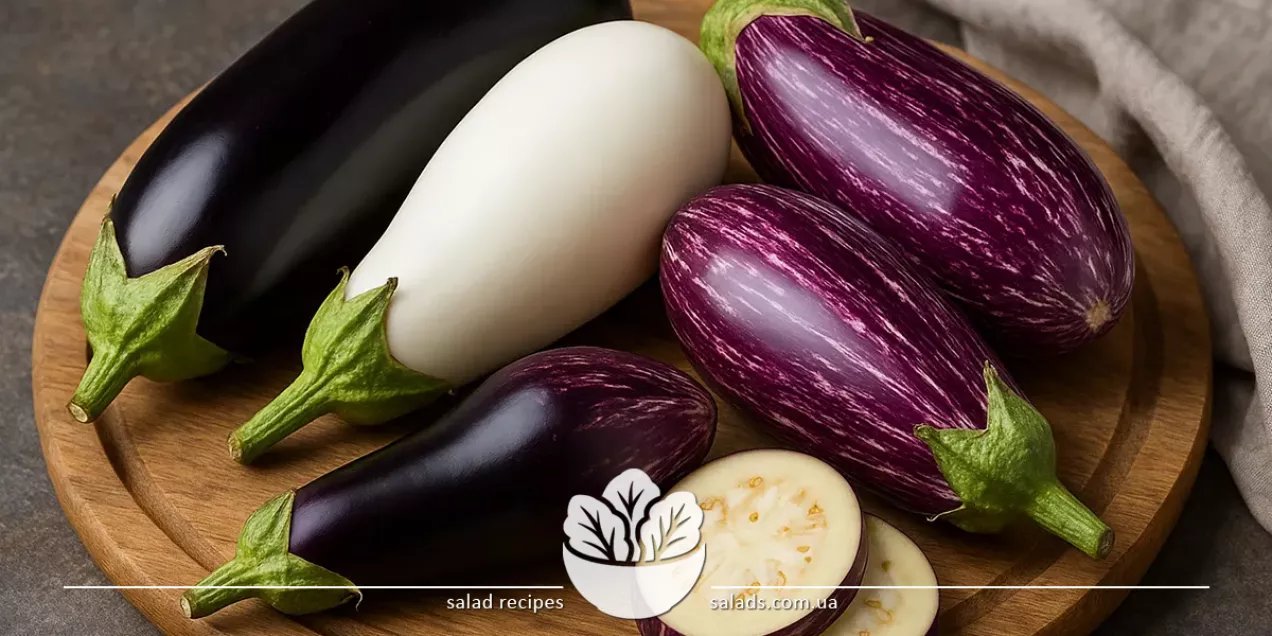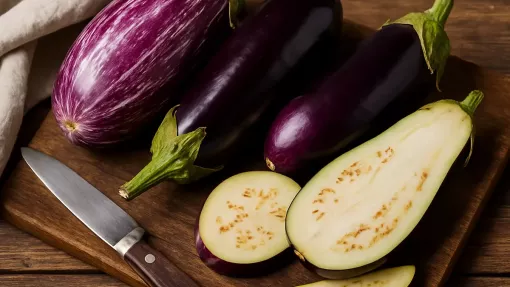Types of Eggplants

Types of eggplants include a wide range of shapes, colors, and cooking characteristics. These vegetables are used in cuisines around the world – from Mediterranean to Eastern – in roasted, fried, stewed, or stuffed dishes. Eggplants can be classic purple, white, green, round, or elongated, with flesh of varying density and levels of bitterness. Thanks to their strong ability to absorb the aromas of spices and sauces, they are often the base of many popular recipes. Learn more about other vegetables in the vegetables category.
Different Types of Eggplants
Popular Eggplant Varieties and Their Culinary Uses
Eggplants can differ widely in shape, color, size, and even flavor. The most well-known are the classic elongated purple fruits, often used for baking, frying, or grilling. They have moderately dense flesh, sometimes with a slight bitterness. Before cooking, it is recommended to salt them to remove excess moisture and bitterness. White eggplants have a more delicate texture and a soft, almost sweet flavor. Though less common, they are perfect for casseroles and stuffing. With fewer seeds and no bitterness, they don’t require soaking beforehand. Their skin is also softer than that of purple varieties, reducing cooking time.
Striped eggplants are a beautiful addition to any dish. They can feature purple-white or pink-cream patterns, and their flavor depends on the variety. Usually, they are softer and juicier than classic types, making them ideal for sautés, vegetable stews, and gratins. Round varieties are another option, particularly popular in Asian cuisine. Their compact size makes them great for frying in oil or quick stewing. Elongated, medium-sized eggplants are very versatile. They slice easily into rounds or strips and are ideal for grilling, baking with sauce, or stuffing with meat, rice, or vegetables. They hold their shape well, absorb sauces, and develop a soft, creamy texture when baked. In salads and antipasti, these eggplants pair wonderfully with tomatoes – another essential vegetable in plant-based dishes.
Eggplants in Casseroles, Stews, and Vegetable Dishes
Eggplants are a staple in dishes where a soft, rich texture and the ability to absorb sauces and spices are key. In casseroles, they combine beautifully with other vegetables, meat, cheese, cream, or tomato sauce. One of the most famous examples is moussaka – a Greek layered dish with eggplants, minced meat, béchamel, and spices. In Italian cuisine, eggplants are baked with Parmesan cheese, basil, and tomatoes – the dish is called parmigiana di melanzane. In vegetable stews, eggplants often take center stage. They are commonly paired with zucchini, peppers, tomatoes, carrots, onions, and herbs. This combination is typical of ratatouille – a classic French dish where each vegetable retains its shape while contributing to a harmonious flavor blend. Eggplants absorb tomato juices and herb aromas, becoming soft and tender.
For sautés and eggplant-based spreads, the eggplants are usually fried or stewed beforehand. After thermal treatment, the flesh breaks down easily, making it a good base for creamy textures. In home cooking, eggplants are often added to vegetable mixes with carrots, tomatoes, and onions. They also pair well with sweet peppers, creating a natural flavor balance – eggplant bitterness and pepper sweetness complement each other. This duo forms the basis for many appetizers, sautés, spreads, casseroles, and even soups, especially when a colorful vegetable base is desired.
Stuffed and Baked Eggplants
Stuffed eggplants are a versatile dish that can be tailored to suit any taste – meat-based, vegetarian, or even vegan. The classic version involves cutting the eggplants lengthwise, removing part of the flesh, and filling the boats with a mixture of ground meat, vegetables, herbs, and spices. The filling is often enriched with cheese, rice, or bulgur. The eggplants are then baked until soft with a golden crust. In vegetarian versions, the filling consists of vegetables – onion, carrot, tomato, pepper – and may include legumes or grains. These eggplants work well as a hot dish or cold appetizer. For extra flavor, they can be topped with grated cheese or drizzled with a sauce – tomato, béchamel, or garlic yogurt.
Eggplants can also be baked whole, then sliced and served with sauce. Slow baking produces a tender, creamy interior that easily separates from the skin. This method is perfect for making eggplant spread, cream soup, or pâté. Fire-roasted or grilled eggplants develop a smoky aroma and are used in Middle Eastern and Balkan dishes. Eggplants pair especially well with onions – together, they create the base for many baked and stewed recipes. Onion adds sweetness, aroma, and depth to the eggplant’s flavor, especially when pre-fried or caramelized.
Eggplants in World Cuisines
Eggplants are among the most versatile vegetables used in culinary traditions around the world. In Mediterranean cuisine, they are the base for dishes such as Greek moussaka, Italian parmigiana, and Turkish imam bayildi. These dishes revolve around the tender flesh of eggplants combined with tomatoes, onions, garlic, spices, and aromatic herbs. Eggplants can serve as the main ingredient or as a base for sauces and side dishes. In Indian cuisine, eggplants are often fried with spices or prepared as a mash-like dish called baingan bharta. It has a bold aroma, spicy taste, and is served with bread or rice. In the Middle East, eggplant spread baba ghanoush is popular, along with roasted or fried vegetable dishes with tahini, lemon juice, and garlic. In the Caucasus region, eggplants are served with nut pastes, herbs, and spicy sauces.
In Asia, eggplants are often stewed in soy sauce with ginger, sesame, and garlic. In Chinese cuisine, they may be deep-fried and served with sweet-and-sour or spicy sauce. In Japanese cooking, they’re served in mirin sauce or baked with miso paste. They are also used as roll fillings and served with rice or fried tofu. Regardless of the region, eggplants are frequently combined with garlic, which adds pungency and aroma. This classic pairing enhances the eggplant’s flavor and makes it a foundation for many global culinary creations.
How to Choose, Store, and Cook Eggplants
To ensure eggplants are tasty and not bitter, it's important to select them properly. The fruit should be firm, springy, and have smooth, glossy skin without spots or cracks. The stem should be green and fresh. If the eggplant is too soft, discolored, or has a dry stem, it’s likely overripe or spoiled. In ripe but not old vegetables, bitterness is almost absent. Eggplants should be stored at 8-12 °C in a cool, well-ventilated place. In the refrigerator, they may wilt or lose flavor, especially over time. To prevent drying out, wrap the fruits in paper or a napkin. Avoid plastic bags – in high humidity, eggplants spoil quickly.
Before cooking, eggplants are often sliced and salted, then left for 15-30 minutes to draw out excess moisture and bitterness. The pieces are then rinsed and dried. This is especially important for large or dark-purple varieties. If there's no bitterness and the flesh is tender, soaking is unnecessary. For baking, eggplants can be cut lengthwise, into rounds or cubes, brushed with oil and seasonings. They absorb sauces, spices, and herbs well. Eggplants pair excellently with cabbage – often added to vegetable stews or served separately as a side dish. The contrast of soft, juicy eggplants and crunchy, delicate cabbage creates an interesting texture and adds volume and freshness to the dish.
